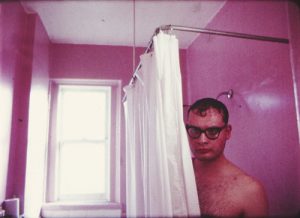After last month’s screening highlighted proto-queer filmmaker Jack Smith, it only seemed appropriate to continue our examination of underground New York filmmakers in the 1960s with the lo-fi pleasures of George Kuchar. With many experimental filmmakers working within the abstract, Kuchar’s work stands out by experimenting with film and digital form while employing more traditional narrative forms.
George Kuchar’s prolific career began in his teens in the 1950s in the Bronx, shooting 8mm films with his twin brother Mike. Working alongside underground filmmakers such as Andy Warhol, Stan Brakhage, Kenneth Anger, and Ken Jacobs, Kuchar was introduced to Jonas Mekas, who brought prominence to Kuchar’s work via the Village Voice and other outlets. Each of these filmmakers cover different areas of avant-garde filmmaking; what distinguishes Kuchar’s work from other underground filmmakers at this time is his faux-avant-garde aesthetic and hyperbolic odes to Hollywood melodrama. Titles such as Pussy on a Hot Tin Roof (1961), Corruption of the Damned (1965), and The Devil’s Cleavage(1973) poke fun at Hollywood, and yet act as an homage to the filmmaking conventions that influenced him. Kuchar primarily worked with nonprofessional actors and a very low budget: Kodachrome reversal stock, garish makeup, and primitive special effects were marks of a Kuchar film. There’s a playfulness in his work that’s charming and captivating; even in moments that share a profound sense of struggle (many of his films touch on his personal depression), Kuchar deftly uses stock music, out-of-sync sound, and his actors’ amateurishness to infuse humor into his work. Kuchar’s work reminds me that experimental filmmaking can be fun – that experimenting with filmmaking techniques and processes can hash out deeper meaning while poking fun at filmmaking itself.
Kuchar moved to San Francisco in 1971, accepting a teaching position at the San Francisco Art Institute. Working collaboratively with his students, Kuchar made the bulk of his movies during his 35-year tenure at the school. Once cheaper camcorders became available, Kuchar switched from small-gauge film to video. His video works were largely personal diaries, and Kuchar spared no details: these video diaries could feature his thoughts on farts, the weather, love, or his appetite. Of these videos, Kuchar’s annual pilgrimage to El Reno, Oklahoma to chase tornadoes, a series entitled Weather Diary Series, are some of his more popular and widely seen works. The transition from film to video seemed to be an easy one for Kuchar: and with the ease of turning on a camcorder, he took his audience deeper into his personal life and ruminations. Elements of camp pervade his video work as well, with consumer-grade special effects and similar themes from his film work present in many of his videos. Kuchar demonstrates a clear command over the format he choses, using the chosen format to connect his work visually and thematically.
To highlight Kuchar’s early career working on 16mm, I’ve selected Hold Me While I’m Naked (1966), one of his most prominent films, and Color Me Shameless (1967), a black and white title that demonstrates his self-deprecating humor. This screening is just the very tip of the iceberg that is Kuchar’s filmic life, and you can be sure that we’ll be revisiting him again (perhaps in his video work) in the future.




